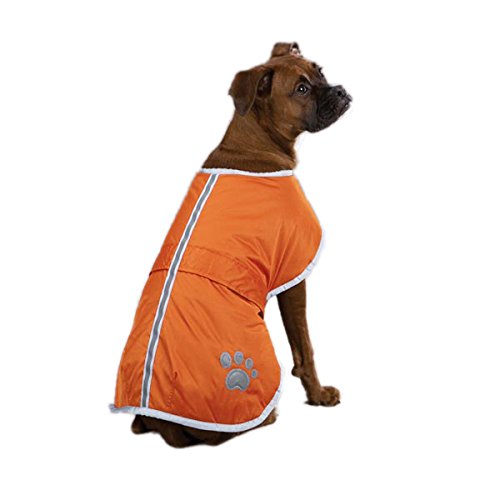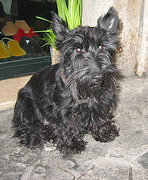

Any untrained dog may be a nuisance, but a large untrained dog may be a danger. For a smooth and well-adjusted assimilation into its human family, a dog must receive at least a basic amount of training.
A dog receiving a sound foundation of training will be housebroken and will respond to the commands "No," "Heel," "Sit," "Stay," and "Come." The dog's obedience to these five commands will enable its handler to control the dog in almost any situation and control of the dog is the essence of training To establish this control, it is necessary to be consistent: the dog must always obey a learned command; if you are not prepared to enforce your command, do not give it.
Equipment for Training Dogs. It is important to use the correct equipment in training dogs. For the new puppy, a show lead is perhaps the most practical item. A show lead, with its adjustable collar, will fit any size dog, and the collar can be let out while the dog is growing. The training, or choke, collar should not be used atil it is time for serious training. When the choke collar, or chain, is used, it is extremely important to allow for its quick release by placing it on the dog correctly. With the dog on your left side, the leash fastens to the ring of the choke chain that passes over the dog's neck. If placed correctly, the collar will loosen when you slacken it.
Commands No. The most important single word any dog can learn is "no," and it should be used whenever the dog does something wrong or is about to do something wrong. The command is taught by using it simultaneously with some form of chastisement. For example, if the dog tries to chase other dogs, cats, or flying leaves, tne leash should be jerked and the dog reprimanded with a sharply spoken "No!"
Heel. The more formal type of training should begin with the command "heel." "Heel" simply means that the dog walks on the handler's left side without pulling on the leash or lagging behind. The dog keeps its head aligned with the handler's legs.
Training is begun with the dog at your left side. Step off briskly on your left foot and give the command, "Heel!" The puppy will attempt to run ahead. This forward motion should be stopped by jerking on the leash or rapidly pivoting on your right foot and walking swiftly in the opposite direction, while repeating the command "Heel!" This right about turn will provide a sharp correction. Anytime the dog becomes unmanageable, repeat the right about turn. This rapid turn will also keep the dog on your left side. If the dog lags behind, it should be encouraged and coaxed forward and not jerked.
Sit. After the dog is heeling reasonably well, you may start working on the sit." The trained dog will sit automatically every time his handler comes to a halt. To teach the dog to sit, walk at a brisk pace with the dog on your left and then gradually slow down. As you slow down, shorten up on the leash with your right hand and move your right hand directly over the dog's head; when you come to a halt, pull up on the leash with your right hand and push down on the dog's rump with your left hand. As you apply this pressure and force the dog into a sit position, use the command, "Sit!"
Stay. Once the dog will sit on command, you are ready to start working on the "stay." Start practicing this exercise with the dog sitting at your left side and the leash in your right hand. Place the palm of your left hand directly in front of the dog's nose and give the command "Stay!" in a long, drawn out, reassuring tone of voice. ( If the dog attempts to lick or nuzzle your hand, jerk on the leash and say "No!" ) Repeat the command "Stay!" and then step directly in front of the dog by pivoting on your left foot. Repeat the command "Stay!" and pivot back to the dog's side. Repeat this exercise two or three more times.
After you have told the dog to stay and are standing directly in front of him, you may now start to slowly back away. If your dog starts to get up, jerk on the leash and command, "No! Sit! Staaay!" Return to your dog's side, pat him on the head and praise him. Gradually, extend the distance that you can move away from your dog, until you can reach the end of the leash.
Come. After your dog has learned the "Sit- Stay" well enough so you may move out to the end of the leash, you may start working on the recall, or the word "come." Use the dog's name followed by the word "come." Gently tug on the leash and encourage your dog to move toward you. If your dog seems apprehensive, squat down a bit, and repeat its name and the command in an encouraging tone. If it seems a little slow in responding, back away and repeat its name; encourage it toward you. As it comes toward you, gather the leash in your hands so you will have a minimum amount of slack when is reaches you. When the dog is directly in front of you, give the command "Sit!" and lavish it with praise as soon as it obeys.
Housebreaking. "Paper breaking" is teaching a dog to relieve itself indoors on paper rather than out-of-doors. "Housebreaking" is teaching a dog to relieve itself outside at all times. Many people believe that paper breaking is a prerequisite to housebreaking. This is incorrect. To paperbreak a dog before housebreaking merely increases the problems.
Housebreaking begins as soon as you get your puppy. Take it out early and often. It should be taken out first thing in the morning and last thing at night. Its outings should be frequent and evenly spaced. It is an excellent idea to arrange an outing immediately after meals and after heavy exertion. Confine the dog to a small area. Dogs are basically clean animals and do not wish to soil their immediate areas. Therefore, the smaller the area, the better. You may limit the dog's space with some kind of obstacle.
 Do You Know Whats In Your Pet Food? Are You Sure?
Owners of dogs and cats who
Do You Know Whats In Your Pet Food? Are You Sure?
Owners of dogs and cats who
 Top 10 Healthiest Dog Breeds
Woof!No other animal has aid
Top 10 Healthiest Dog Breeds
Woof!No other animal has aid
 How To Prepare For Getting Your First Puppy
So its that time in your lif
How To Prepare For Getting Your First Puppy
So its that time in your lif
 Dog Coats for Winter
Our dogs are part of our fam
Dog Coats for Winter
Our dogs are part of our fam
 Scottish Terrier Breeder Interview: Cindy Cooke Tells Us About Scotties
Scottish Terrier Breeder Interview
Cindy Cooke has been wor
Scottish Terrier Breeder Interview: Cindy Cooke Tells Us About Scotties
Scottish Terrier Breeder Interview
Cindy Cooke has been wor
Copyright © 2005-2016 Pet Information All Rights Reserved
Contact us: www162date@outlook.com